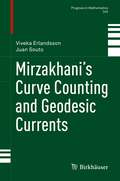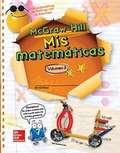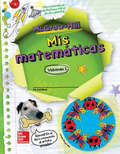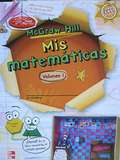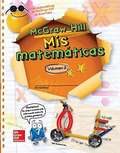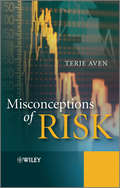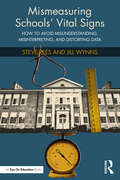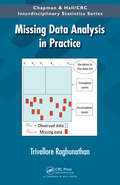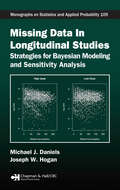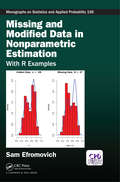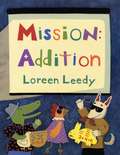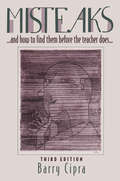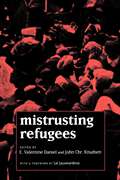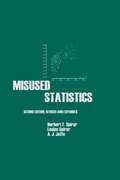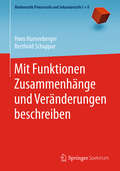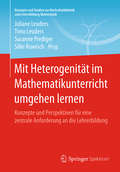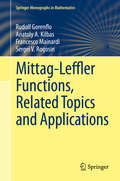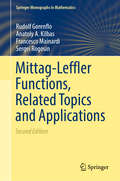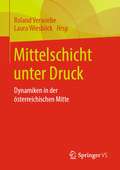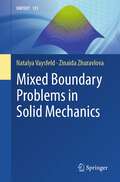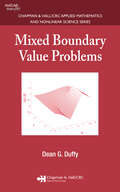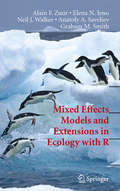- Table View
- List View
Mirzakhani’s Curve Counting and Geodesic Currents (Progress in Mathematics #345)
by Viveka Erlandsson Juan SoutoThis monograph presents an approachable proof of Mirzakhani’s curve counting theorem, both for simple and non-simple curves. Designed to welcome readers to the area, the presentation builds intuition with elementary examples before progressing to rigorous proofs. This approach illuminates new and established results alike, and produces versatile tools for studying the geometry of hyperbolic surfaces, Teichmüller theory, and mapping class groups. Beginning with the preliminaries of curves and arcs on surfaces, the authors go on to present the theory of geodesic currents in detail. Highlights include a treatment of cusped surfaces and surfaces with boundary, along with a comprehensive discussion of the action of the mapping class group on the space of geodesic currents. A user-friendly account of train tracks follows, providing the foundation for radallas, an immersed variation. From here, the authors apply these tools to great effect, offering simplified proofs of existing results and a new, more general proof of Mirzakhani’s curve counting theorem. Further applications include counting square-tiled surfaces and mapping class group orbits, and investigating random geometric structures. Mirzakhani’s Curve Counting and Geodesic Currents introduces readers to powerful counting techniques for the study of surfaces. Ideal for graduate students and researchers new to the area, the pedagogical approach, conversational style, and illuminating illustrations bring this exciting field to life. Exercises offer opportunities to engage with the material throughout. Basic familiarity with 2-dimensional topology and hyperbolic geometry, measured laminations, and the mapping class group is assumed.
Mis Mates [Grade 4], Volumen 1 (Elementary Math Connects)
by McGraw EducationNIMAC-sourced textbook
Misconceptions of Risk (Statistics In Practice Ser.)
by Terje AvenWe all face risks in a variety of ways, as individuals, businesses and societies. The discipline of risk assessment and risk management is growing rapidly and there is an enormous drive for the implementation of risk assessment methods and risk management in organizations. There are great expectations that these tools provide suitable frameworks for obtaining high levels of performance and balance different concerns such as safety and costs. The analysis and management of risk are not straightforward. There are many challenges. The risk discipline is young and there area a number of ideas, perspectives and conceptions of risk out there. For example many analysts and researchers consider it appropriate to base their risk management policies on the use of expected values, which basically means that potential losses are multiplied with their associated consequences. However, the rationale for such a policy is questionable. A number of such common conceptions of risk are examined in the book, related to the risk concept, risk assessments, uncertainty analyses, risk perception, the precautionary principle, risk management and decision making under uncertainty. The Author discusses these concepts, their strenghts and weaknesses, and concludes that they are often better judged as misconceptions of risk than conceptions of risk. Key Features: Discusses common conceptions of risk with supporting examples. Provides recommendations and guidance to risk analysis and risk management. Relevant for all types of applications, including engineering and business. Presents the Author’s overall conclusions on the issues addressed throughout the book. All those working with risk-related problems need to understand the fundamental ideas and concepts of risk. Professionals in the field of risk, as well as researchers and graduate sutdents will benefit from this book. Policy makers and business people will also find this book of interest.
Mismeasuring Schools’ Vital Signs: How to Avoid Misunderstanding, Misinterpreting, and Distorting Data
by Steve Rees Jill WynnsThis book helps school and district leaders avoid the pitfalls that await those making sense of their school’s data. Whether you're interpreting achievement gaps, graduation rates or test results, you're at risk of reaching a mistaken judgment. By learning about common errors and how they’re made, you'll be ready to choose safer, surer paths to making better sense of the wealth of data in your school or district. The authors help educators build better evidence, see conclusions more clearly, and explain the data more persuasively. Special features Include: "Questions to Spark Discussion" in each chapter encourage school site, district leaders, and board trustees to apply each chapter’s content to their own situations. Data visualizations, together with the authors’ interpretations, will help you learn how to do visual analysis (and reach the right conclusions). Practical tips provide clear guidance. Supplemental resources can be found at the book’s website, k12measures.com, including interactive data visualizations and analytic exercises to help you learn a concept by "doing."
Missing Data
by John W. GrahamMissing data have long plagued those conducting applied research in the social, behavioral, and health sciences. Good missing data analysis solutions are available, but practical information about implementation of these solutions has been lacking. The objective of Missing Data: Analysis and Design is to enable investigators who are non-statisticians to implement modern missing data procedures properly in their research, and reap the benefits in terms of improved accuracy and statistical power. Missing Data: Analysis and Design contains essential information for both beginners and advanced readers. For researchers with limited missing data analysis experience, this book offers an easy-to-read introduction to the theoretical underpinnings of analysis of missing data; provides clear, step-by-step instructions for performing state-of-the-art multiple imputation analyses; and offers practical advice, based on over 20 years' experience, for avoiding and troubleshooting problems. For more advanced readers, unique discussions of attrition, non-Monte-Carlo techniques for simulations involving missing data, evaluation of the benefits of auxiliary variables, and highly cost-effective planned missing data designs are provided. The author lays out missing data theory in a plain English style that is accessible and precise. Most analysis described in the book are conducted using the well-known statistical software packages SAS and SPSS, supplemented by Norm 2.03 and associated Java-based automation utilities. A related web site contains free downloads of the supplementary software, as well as sample empirical data sets and a variety of practical exercises described in the book to enhance and reinforce the reader's learning experience. Missing Data: Analysis and Design and its web site work together to enable beginners to gain confidence in their ability to conduct missing data analysis, and more advanced readers to expand their skill set.
Missing Data Analysis in Practice (Chapman & Hall/CRC Interdisciplinary Statistics)
by Trivellore RaghunathanMissing Data Analysis in Practice provides practical methods for analyzing missing data along with the heuristic reasoning for understanding the theoretical underpinnings. Drawing on his 25 years of experience researching, teaching, and consulting in quantitative areas, the author presents both frequentist and Bayesian perspectives. He describes ea
Missing Data in Longitudinal Studies: Strategies for Bayesian Modeling and Sensitivity Analysis (Chapman & Hall/CRC Monographs on Statistics and Applied Probability)
by Michael J. Daniels Joseph W. HoganDrawing from the authors' own work and from the most recent developments in the field, Missing Data in Longitudinal Studies: Strategies for Bayesian Modeling and Sensitivity Analysis describes a comprehensive Bayesian approach for drawing inference from incomplete data in longitudinal studies. To illustrate these methods, the authors employ
Missing Mittens (MathStart, Odd and Even Numbers)
by Stuart J. MurphyMISSING MITTENS. Every animal on Farmer Bill's farm is missing one mitten. Readers can investigate odd and even numbers as they unravel this mitten mystery!
Missing and Modified Data in Nonparametric Estimation: With R Examples (Chapman & Hall/CRC Monographs on Statistics and Applied Probability)
by Sam EfromovichThis book presents a systematic and unified approach for modern nonparametric treatment of missing and modified data via examples of density and hazard rate estimation, nonparametric regression, filtering signals, and time series analysis. All basic types of missing at random and not at random, biasing, truncation, censoring, and measurement errors are discussed, and their treatment is explained. Ten chapters of the book cover basic cases of direct data, biased data, nondestructive and destructive missing, survival data modified by truncation and censoring, missing survival data, stationary and nonstationary time series and processes, and ill-posed modifications. <P><P> The coverage is suitable for self-study or a one-semester course for graduate students with a prerequisite of a standard course in introductory probability. Exercises of various levels of difficulty will be helpful for the instructor and self-study. <P><P> The book is primarily about practically important small samples. It explains when consistent estimation is possible, and why in some cases missing data should be ignored and why others must be considered. If missing or data modification makes consistent estimation impossible, then the author explains what type of action is needed to restore the lost information. <P><P> The book contains more than a hundred figures with simulated data that explain virtually every setting, claim, and development. The companion R software package allows the reader to verify, reproduce and modify every simulation and used estimators. This makes the material fully transparent and allows one to study it interactively. <P><P> Sam Efromovich is the Endowed Professor of Mathematical Sciences and the Head of the Actuarial Program at the University of Texas at Dallas. He is well known for his work on the theory and application of nonparametric curve estimation and is the author of Nonparametric Curve Estimation: Methods, Theory, and Applications. Professor Sam Efromovich is a Fellow of the Institute of Mathematical Statistics and the American Statistical Association.
Mission - Addition
by Loreen LeedyMiss Prime and her animal students explore addition by finding many examples in the world around them.
Misteaks. . . and how to find them before the teacher does. . .: A Calculus Supplement, 3rd Edition
by Barry CipraAn unusual supplement to every calculus textbook, Misteaks and How to Find Them before the Teacher Does is popular with students and teachers alike. Teachers love the way it encourages students to truly think about mathematics rather than simply plugging numbers into equations to crank out answers, and students love the author's straightforward, tongue-in-cheek style. The title of this light-hearted and amusing book might well have been "Going Gray in Elementary Calculus and How to Avoid it." Changing the metaphor, Barry has hit the nail on the finger in hundreds of fine examples. --Philip J. Davis, coauthor of The Mathematical Experience. "How I wish that something like this had been available when I was a student!" --Ralph P. Boas, former editor of The American Mathematical Monthly. Bonus: Solution to LeWitt Puzzle
Mistrusting Refugees
by E. Valentine Daniel John Chr. KnudsenThe twentieth century has seen people displaced on an unprecedented scale and has brought concerns about refugees into sharp focus. There are forty million refugees in the world—1 in 130 inhabitants of this planet. In this first interdisciplinary study of the issue, fifteen scholars from diverse fields focus on the worldwide disruption of "trust" as a sentiment, a concept, and an experience.Contributors provide a rich array of essays that maintain a delicate balance between providing specific details of the refugee experience and exploring corresponding theories of trust and mistrust. Their subjects range widely across the globe, and include Palestinians, Cambodians, Tamils, and Mayan Indians of Guatemala. By examining what individuals experience when removed from their own culture, these essays reflect on individual identity and culture as a whole.
Misused Statistics
by Herbert Spirer Louise Spirer"Revised and updated edition of a standard in the field. Alerts readers to the problems, inherent in statistical practice-illustrating the types of misused statistics with well-documented, real-world examples, nearly half new to this edition, drawn from a wide range of areas, including the media, public policy, polls and surveys, political election
Mit Funktionen Zusammenhänge und Veränderungen beschreiben (Mathematik Primarstufe und Sekundarstufe I + II)
by Berthold Schuppar Hans HumenbergerIn diesem Buch soll gezeigt werden, was Funktionen in der Mathematik und in Anwendungssituationen leisten können bzw. sollen. Funktionen haben bekanntlich viele Gesichter, und das Thema ist im schulischen Mathematikunterricht und auch in den Lehramtsstudiengängen prominent vertreten. Da ist es natürlich besonders wichtig, dass Studierende einen angemessenen Zugang zu diesem Thema bekommen, sodass sie einen solchen auch an ihre zukünftigen Schüler/innen weitergeben können. Im Buch werden viele praktische und fachwissenschaftliche Aspekte angesprochen und miteinander vernetzt (z. B. zur Geometrie und zur Stochastik), die u. E. zu einem tragfähigen Gesamtbild von „Elementaren Funktionen“ führen, wobei sich an manchen Stellen auch fachdidaktische Betrachtungen finden. Dabei sollen weder Realitätsbezüge noch innermathematische Zusammenhänge und Begründungen zu kurz kommen. Dem nicht ganz leichten Ziel, Verständlichkeit und mathematische Exaktheit miteinander zu verbinden, wollen wir mit diesem Buch ein Stück näher kommen. Zahlreiche Aufgaben (teilweise mit Lösungshinweisen) runden jedes Kapitel ab und sollen Leser/innen zum Üben, Verstehen und Weiterdenken anregen.
Mit Heterogenität im Mathematikunterricht umgehen lernen
by Susanne Prediger Juliane Leuders Timo Leuders Silke RuwischIn diesem Band werden konkrete Konzepte für die Lehreraus- und -weiterbildung diskutiert, in denen Mathematik-Lehrkräfte gezielt beim Unterrichten in heterogenen und insbesondere inklusiven Klassen unterstützt werden. Auf methodischer Ebene steht die Frage im Vordergrund, wie Praxisaspekte in Lehrveranstaltungen und Fortbildungen einbezogen werden können, inhaltlich entsteht ein Spektrum von verschiedenen Themen im Kontext von Heterogenität, wie z.B. Diagnose und Förderung, Differenzierung, Begabung, Sprache und Inklusion.Die zunehmende Heterogenität der Schülerinnen und Schüler stellt für Lehrkräfte eine Herausforderung dar, auf die die Lehrerbildung vorbereiten muss. Besondere Anforderungen ergeben sich in allen Schulformen durch die erhöhte Leistungsheterogenität und durch die Inklusion von Lernenden mit Behinderungen. Der Umgang mit einer Leistungsspanne, die von Lernschwierigkeiten bis hin zu mathematischer Begabung reicht, erfordert hohe fachdidaktische Kompetenzen.
Mittag-Leffler Functions, Related Topics and Applications
by Rudolf Gorenflo Anatoly A. Kilbas Francesco Mainardi Sergei V. RogosinAs a result of researchers' and scientists' increasing interest in pure as well as applied mathematics in non-conventional models, particularly those using fractional calculus, Mittag-Leffler functions have recently caught the interest of the scientific community. Focusing on the theory of the Mittag-Leffler functions, the present volume offers a self-contained, comprehensive treatment, ranging from rather elementary matters to the latest research results. In addition to the theory the authors devote some sections of the work to the applications, treating various situations and processes in viscoelasticity, physics, hydrodynamics, diffusion and wave phenomena, as well as stochastics. In particular the Mittag-Leffler functions allow us to describe phenomena in processes that progress or decay too slowly to be represented by classical functions like the exponential function and its successors. The book is intended for a broad audience, comprising graduate students, university instructors and scientists in the field of pure and applied mathematics, as well as researchers in applied sciences like mathematical physics, theoretical chemistry, bio-mathematics, theory of control and several other related areas.
Mittag-Leffler Functions, Related Topics and Applications (Springer Monographs in Mathematics)
by Rudolf Gorenflo Anatoly A. Kilbas Francesco Mainardi Sergei RogosinThe 2nd edition of this book is essentially an extended version of the 1st and provides a very sound overview of the most important special functions of Fractional Calculus. It has been updated with material from many recent papers and includes several surveys of important results known before the publication of the 1st edition, but not covered there.As a result of researchers’ and scientists’ increasing interest in pure as well as applied mathematics in non-conventional models, particularly those using fractional calculus, Mittag-Leffler functions have caught the interest of the scientific community. Focusing on the theory of Mittag-Leffler functions, this volume offers a self-contained, comprehensive treatment, ranging from rather elementary matters to the latest research results. In addition to the theory the authors devote some sections of the work to applications, treating various situations and processes in viscoelasticity, physics, hydrodynamics, diffusion and wave phenomena, as well as stochastics. In particular, the Mittag-Leffler functions make it possible to describe phenomena in processes that progress or decay too slowly to be represented by classical functions like the exponential function and related special functions.The book is intended for a broad audience, comprising graduate students, university instructors and scientists in the field of pure and applied mathematics, as well as researchers in applied sciences like mathematical physics, theoretical chemistry, bio-mathematics, control theory and several other related areas.
Mittelschicht unter Druck: Dynamiken in der österreichischen Mitte
by Roland Verwiebe Laura WiesböckIn Europa schrumpft die Mittelschicht, was für eine Reihe von EU-Mitgliedsländern bislang kaum untersucht wurde. Dies trifft auch auf Österreich zu, welches sich durch Umbau der Sozialpolitik, Flexibilisierung des Arbeitsmarktes, Zuwanderung und einem Aufstieg rechter politischer Parteien in einem starken Umbruchprozess befindet. Dies ist der Hintergrund für eine in diesem Sammelband erstmalig vorgenommene Analyse des Schrumpfens der österreichischen Mittelschicht. Der Band ist multidisziplinär angelegt (Autor*innen aus Soziologie, Ökonomie, Politikwissenschaft, Zeitgeschichte), und versammelt theoretisch orientierte und empirische Beiträge etablierter Autor*innen wie auch Nachwuchswissenschaftler*innen.
Mixed Boundary Problems in Solid Mechanics (UNITEXT #155)
by Natalya Vaysfeld Zinaida ZhuravlovaThe book covers a wide range of subjects and techniques related to mixed boundary problems of elasticity from basic concepts to special techniques that are unlikely to appear in traditional university graduate courses. This book may also be of interest to industrial researchers who encounter defects such as cracks and inclusions of different materials in mechanisms under different localization and type of loading. So the topics present the application of mathematical mechanics of solid bodies notably in elasticity, showing the interconnection of elasticity and temperature that would normally treated independently. Theoretical and experimental results are expected to be useful for researchers investigating a wide range of materials including metals, composites, ceramics, polymers, biomaterials and nanomaterials under different mechanical and temperature loading. The aim of the book is to introduce an interdisciplinary audience to a variety of stress state phenomena occurring in elasticity near defects and edges of the bodies. The book is aimed at researchers, primarily but not exclusively graduate students, postdoctoral researchers, specialists from Aerospace and Civil Engineering, Materials Science, and Engineering Mechanics and should naturally also be of interest to specialists of Physics and Applied Mathematics.
Mixed Boundary Value Problems
by Dean G. DuffyMethods for Solving Mixed Boundary Value ProblemsAn up-to-date treatment of the subject, Mixed Boundary Value Problems focuses on boundary value problems when the boundary condition changes along a particular boundary. The book often employs numerical methods to solve mixed boundary value problems and the associated integral equat
Mixed Effects Models and Extensions in Ecology with R
by Neil Walker Elena N. Ieno Graham M. Smith Anatoly A. Saveliev Alain ZuurThis book discusses advanced statistical methods that can be used to analyse ecological data. Most environmental collected data are measured repeatedly over time, or space and this requires the use of GLMM or GAMM methods. The book starts by revising regression, additive modelling, GAM and GLM, and then discusses dealing with spatial or temporal dependencies and nested data.
